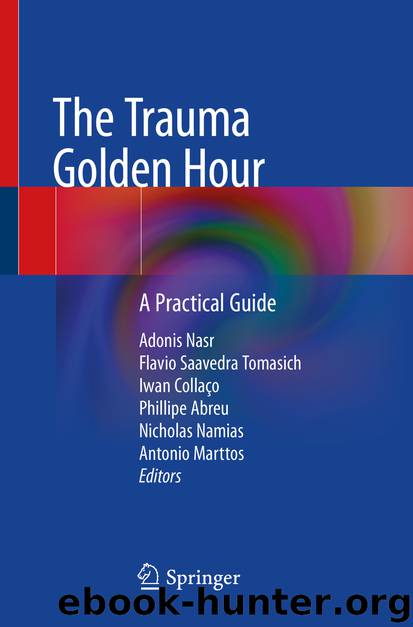The Trauma Golden Hour by Unknown

Author:Unknown
Language: eng
Format: epub
ISBN: 9783030264437
Publisher: Springer International Publishing
17.2 Thoracic Lesions
Most common conditions related to thoracic trauma are pain, bleeding, mechanical instability of the chest wall, and defects of the chest wall.
17.3 Pain
Pain should be managed with careful and effective administration of analgesics. Although analgesics do not cause any direct effect on the stability of the wall or any functional alteration, their use can result in posterior ventilator imbalance by conscious decrease of thoracic mobility.
17.4 Pneumothorax
It is found in more than 20% of trauma in general and it is defined as an air collection in pleural space. It can be classified as simple, open, and hypertensive. Classical findings to all kinds of pneumothorax are respiratory discomfort, decrease of vesicular murmur on the affected side and hyperresonance on percussion. In hypertensive pneumothorax, there is also tracheal deviation to the opposite side of the injury, tachycardia, and jugular distention.
The size of the pneumothorax is not always related to the patient’s clinical presentation, which should be prioritized in the evaluation of the treatment. A closed-chest drainage can be performed in patients with a simple pneumothorax (20–22 French tube) in the fifth or sixth intercostal space in the anterior or midaxillary line. It is preferable to place the tube in the anterior axillary line due to more posterior comfort for the patient.
A simple pneumothorax can evolve to a hypertensive pneumothorax; therefore, the patient should be always carefully monitored. As the first management procedure of a hypertensive pneumothorax, a puncture with a gauge needle (10 to 16 gauge), sufficiently long to penetrate through the chest wall in the second or third intercostal space of the affected hemithorax, in the hemiclavicular line, to an immediate decompression, should be performed, transforming the hypertensive pneumothorax into an open pneumothorax. The next step is to perform a pleural drainage. Besides, patients should receive supplementary oxygen by a mask or undergo an orotracheal intubation with mechanical ventilation when necessary. A chest X-ray should be performed after the placement of the tube to verify if it is in place and if the drainage is effective.
During pre-hospital care, sucking chest wounds should be managed with a dressing that seals the wound in three sides to create a valve mechanism (allowing the exit of the air during expiration and preventing its entrance during inspiration). During hospitalar care, the chest drainage is preconized through a different site from the wound – which should be closed by occlusive dressing or synthesis of the skin by separated stitches – and orotracheal intubation when necessary. Bigger defects should be managed surgically by thoracotomy with correction of the lesion, closed-chest drainage, and mechanical ventilation with positive pressure.
Download
This site does not store any files on its server. We only index and link to content provided by other sites. Please contact the content providers to delete copyright contents if any and email us, we'll remove relevant links or contents immediately.
Waking Up in Heaven: A True Story of Brokenness, Heaven, and Life Again by McVea Crystal & Tresniowski Alex(37715)
Empire of the Sikhs by Patwant Singh(23021)
We're Going to Need More Wine by Gabrielle Union(19003)
Hans Sturm: A Soldier's Odyssey on the Eastern Front by Gordon Williamson(18529)
Leonardo da Vinci by Walter Isaacson(13235)
The Radium Girls by Kate Moore(11970)
Tools of Titans by Timothy Ferriss(8304)
Educated by Tara Westover(8001)
How to Be a Bawse: A Guide to Conquering Life by Lilly Singh(7435)
Permanent Record by Edward Snowden(5795)
The Last Black Unicorn by Tiffany Haddish(5601)
The Rise and Fall of Senator Joe McCarthy by James Cross Giblin(5246)
Promise Me, Dad by Joe Biden(5112)
The Wind in My Hair by Masih Alinejad(5056)
A Higher Loyalty: Truth, Lies, and Leadership by James Comey(4905)
The Crown by Robert Lacey(4761)
The Iron Duke by The Iron Duke(4319)
Joan of Arc by Mary Gordon(4053)
Stalin by Stephen Kotkin(3918)
